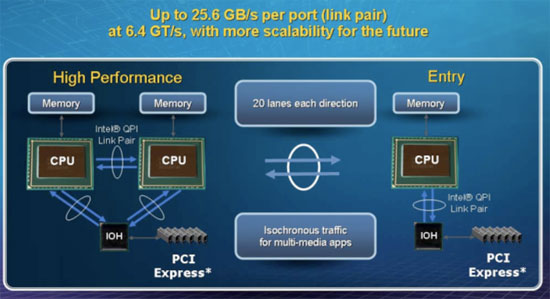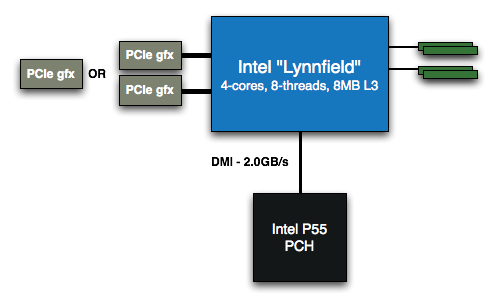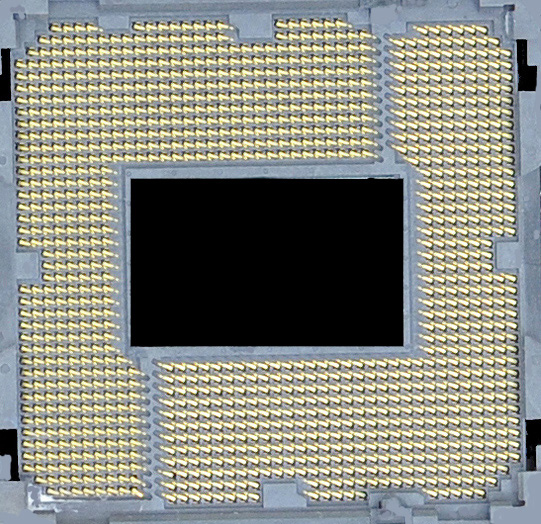The Lynnfield Preview: Rumblings of Revenge
by Anand Lal Shimpi on May 29, 2009 1:00 PM EST- Posted in
- CPUs
Making Nehalem Affordable: LGA-1156
Take the Core i7, shave off one memory controller and replace the high bandwidth QPI link with Intel’s slower DMI and you’ve got the makings of a (more) mainstream Nehalem.
Many have been calling this processor the Core i5 although I’m not quite ready to jump on that bandwagon, so I’ll keep referring to it by its socket (LGA-1156) or codename (Lynnfield).
Intel’s QPI is a very fast bus delivering up to 25.6GB/s of bandwidth. The image below shows you how Intel sees it being useful:

If you’ve got a multi-socket system (e.g. dual processor Xeon workstation, or Skulltrail successor) or if you’ve got a lot of high bandwidth PCIe devices (e.g. multi-GPU or lots of Larrabees) then QPI makes a whole lot of sense. However, if you’ve got a single socket system and aren’t running a lot of high bandwidth PCIe devices then QPI is overkill.
Intel’s DMI is the link used between the X58 chipset and the ICH10 I/O controller, it’s a much more conservative bus capable of delivering 2 - 4GB/s of bandwidth. That’s enough bandwidth for things like SATA and USB but a single PCIe x16 slot can deliver 16GB/s of bandwidth, far too much for Intel’s DMI.
Instead of crippling graphics on its mainstream platform, Intel did the next best thing and integrated 16 PCIe 2.0 lanes onto the die of its mainstream Nehalem part.
What you get looks like this:

A Lynnfield system only need two chips (CPU + PCH) while a Bloomfield system needs three (CPU + IOH + ICH)
The 16 PCIe 2.0 lanes can be configured as one x16 or two x8, allowing you enough bandwidth and very low latency to do things like CrossFire or SLI. Any additional PCIe lanes will branch off of what Intel is now calling the Platform Controller Hub (PCH). The first PCH is Intel’s P55 chipset; all you need is a Lynnfield CPU and the P55 PCH, no additional ICH is necessary as all of that functionality is embedded in the PCH.
The price of Intel’s P55 PCH is also much lower than the X58 chipset, in fact P55 is expected to be price competitive with P45 + ICH10. In other words, we should eventually see P55 boards priced at $100 or less.
Getting rid of QPI and one of the three DDR3 channels knocked down the pin-count of LGA-1366, but adding in 16 PCIe 2.0 lanes brought it back up to 1156 which you can count in the socket below:

I’ve blacked out the motherboard around it and the caps in the middle to protect the innocent.










95 Comments
View All Comments
ssj4Gogeta - Friday, May 29, 2009 - link
There's always the dual-core Nehalem Clarkdale for the mainstream market. And I think they'll launch lower clock Lynnfields too, like Anand said.I think Intel did a good job by separating its high-end processors from the mainstream ones and launching them as a different series. So now instead of having one $1200 extreme part, we have 3 high-end parts, with the lowest priced one a very affordable option for geeks who are on a budget.
ssj4Gogeta - Friday, May 29, 2009 - link
Congratulations Intel, you've created a beast.What is AMD going to do now? I don't think they have any new cores ready for launch this year. If Lynnfield offers the same performance as i7 920 for Phenom II prices, AMD will either have to bump up their clock speeds ridiculously, or lower their prices yet again. Things aren't looking good for AMD. Lynnfield turns out to be better than I expected.
And I HATE Intel and their tick-tock. Actually I can't decided whether to hate or like it. It's good that they're advancing our planet's technology at a really fast pace so we'll be prepared when aliens attack. But which damn processor do I buy??? They launch a new series every year, and a new stepping every few months. Which one to buy? WHEN to buy??? My parents won't buy me processors every 6 months!
MadMan007 - Friday, May 29, 2009 - link
You could always do what people did back in the day - upgrade when your current hardware no longer does what you need it to do. I know, crazy right!?Griswold - Friday, May 29, 2009 - link
Its only a crazy concept if daddy is paying for those upgrades all the time - you and the rest of us know its the right thing to do. :]Jaramin - Friday, May 29, 2009 - link
Looking at AMD's roadmap, I fear this is going to hurt a lot :( If the pricing is good, it could confine AMD into the lower mainstream segment.Hyperion1400 - Friday, May 29, 2009 - link
That remains to be seen. Don't Istanbul heading for market at around the same time as Core-i5. There has been little information leaked about Istanbul and no performance numbers have come to light. So, as of now, it is impossible to predict how competitive AMD's offerings will be. Not to mention we have Magny Cours to look forward too in 1H 2010.ssj4Gogeta - Friday, May 29, 2009 - link
But Istanbul is just a 6-core Opteron. In other words, a server chip.Hyperion1400 - Saturday, May 30, 2009 - link
As was Barcelona and Shanghai. But, that didn't seem to stop them from releasing them on the main stream market.Spoelie - Saturday, May 30, 2009 - link
but costs would be too prohibitivePhII is already similar in die size as bloomfield, and is forced to be priced lower for competitive reasons.
You think AMD won't be hurting if it sells an even larger die to compete with a smaller-than-bloomfield die, in a market where having more than 6 cores is questionable value at best?
No, only thing amd can do is crank up clock speeds, try to get 3.4 and 3.6ghz models out the door
Spoelie - Saturday, May 30, 2009 - link
Oh and up the uncore clock on them as well, preferably 2.4ghz, but might make them look worse in power consumption comparisons